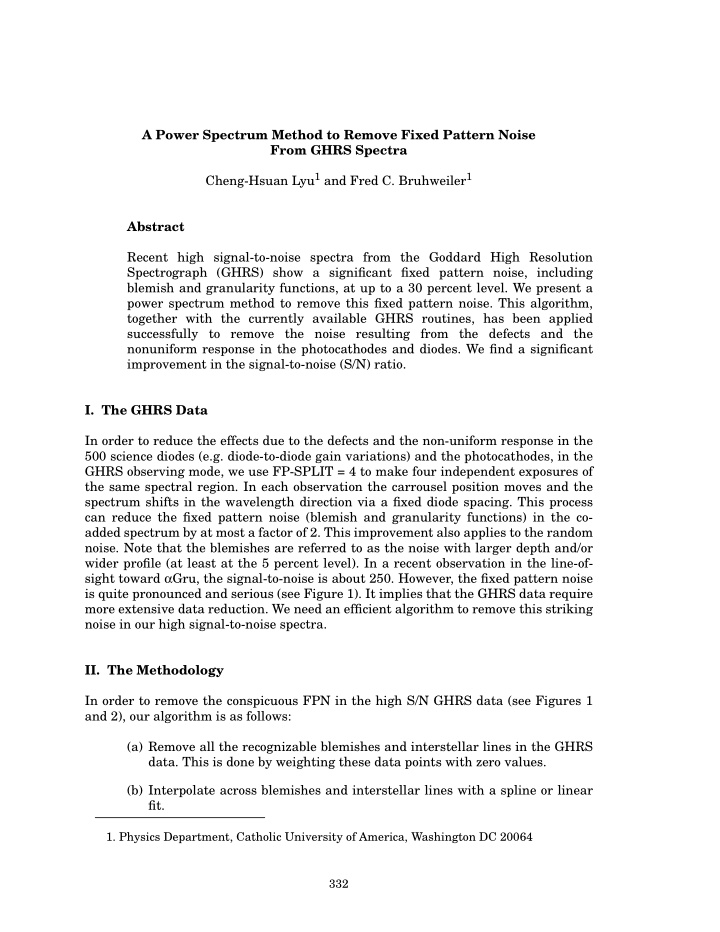



A Power Spectrum Method to Remove Fixed Pattern Noise From GHRS Spectra Cheng-Hsuan Lyu 1 and Fred C. Bruhweiler 1 Abstract Recent high signal-to-noise spectra from the Goddard High Resolution Spectrograph (GHRS) show a significant fixed pattern noise, including blemish and granularity functions, at up to a 30 percent level. We present a power spectrum method to remove this fixed pattern noise. This algorithm, together with the currently available GHRS routines, has been applied successfully to remove the noise resulting from the defects and the nonuniform response in the photocathodes and diodes. We find a significant improvement in the signal-to-noise (S/N) ratio. I. The GHRS Data In order to reduce the effects due to the defects and the non-uniform response in the 500 science diodes (e.g. diode-to-diode gain variations) and the photocathodes, in the GHRS observing mode, we use FP-SPLIT = 4 to make four independent exposures of the same spectral region. In each observation the carrousel position moves and the spectrum shifts in the wavelength direction via a fixed diode spacing. This process can reduce the fixed pattern noise (blemish and granularity functions) in the co- added spectrum by at most a factor of 2. This improvement also applies to the random noise. Note that the blemishes are referred to as the noise with larger depth and/or wider profile (at least at the 5 percent level). In a recent observation in the line-of- sight toward α Gru, the signal-to-noise is about 250. However, the fixed pattern noise is quite pronounced and serious (see Figure 1). It implies that the GHRS data require more extensive data reduction. We need an efficient algorithm to remove this striking noise in our high signal-to-noise spectra. II. The Methodology In order to remove the conspicuous FPN in the high S/N GHRS data (see Figures 1 and 2), our algorithm is as follows: (a) Remove all the recognizable blemishes and interstellar lines in the GHRS data. This is done by weighting these data points with zero values. (b) Interpolate across blemishes and interstellar lines with a spline or linear fit. 1. Physics Department, Catholic University of America, Washington DC 20064 332
A Power Spectrum Method to Remove Pattern Noise from GHRS Spectra Figure 1: Enhanced fixed-pattern-noise (FPN) and obscured interstellar line(s) in high S/N GHRS data. Since the FPN is fixed in the response of the photocathodes and diodes, when we co-add 4 FP-SPLITs in the pixel (or data point) domain directly, we see the enhanced FPN. In addition, among four independent observations (FP-SPLIT=4) of the same spectral region, each spectrum is shifted in the wavelength direction by a constant amount. Thus, in the co-added spectrum in the pixel domain we find that the interstellar lines (IS-lines) appear as four distinct features, separated by ∼ 10 data points. (c) Apply Fast Fourier Transform (FFT) to filter out all the possible high frequency components that appear in the GHRS data (see Figure 3). Then, transform the low-pass filtered data back to their pixel-space domain (see Figure 4). Figure 2: Merged GHRS data with obscured FPN. Similar to Figure 1, but before co- adding four independent spectra we correct their respective shifts in pixel space; then we find sharp interstellar line(s), a series of blemishes, and the noise resulting mainly from granularity. Proceedings of the HST Calibration Workshop 333
C.-H. Lyu and F. C. Bruhweiler Figure 3: The power spectrum after applying FFT and clipping out high frequency components. (d) Use the co-added and enhanced FPN spectrum and the low-pass filtered data to determine the granularity function (see Figure 5). Then, divide the contaminated FP-SPLIT data by this function. (e) After correcting for FPN, the individual FP-SPLITs can be merged to yield the final and real high S/N data (see Figure 6). Figure 4: Low-pass filtered spectrum versus unsmoothed co-added spectrum in pixel space. 334 Proceedings of the HST Calibration Workshop
A Power Spectrum Method to Remove Pattern Noise from GHRS Spectra Figure 5: The extracted FPN (combined blemish and granularity functions) vector. Figure 6: Final reduced corrected high S/N GHRS data after taking out FPN. Comparing this spectrum with that in Figure 2, we find a significant improvement in S/N. Concluding Remarks Comparing our final reduced data (Figure 6) with the contaminated spectrum (Figure 2), one finds a significant improvement in S/N in our GHRS data. This appears to recover the Poisson limited signal-to-noise ratio (S/N = 1/ σ ). Besides, our algorithm is very efficient, for we don't need to do an iterative solution as in the case of the so- called tomographic technique (Gilliland 1993, personal communication) and iterative method (Lindler 1993, personal communication). This methodology, however, is limited to stars with large v sin i . Stars with low v sin i will have larger contributions at high frequencies in the FFT. In any event, one must still inspect each subexposure separately to make certain that we have treated properly all features, both in the source and FPN spectra. Proceedings of the HST Calibration Workshop 335
Recommend
More recommend